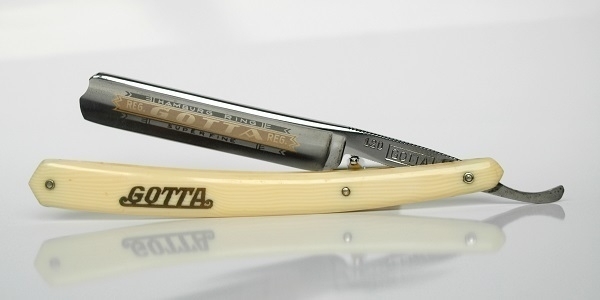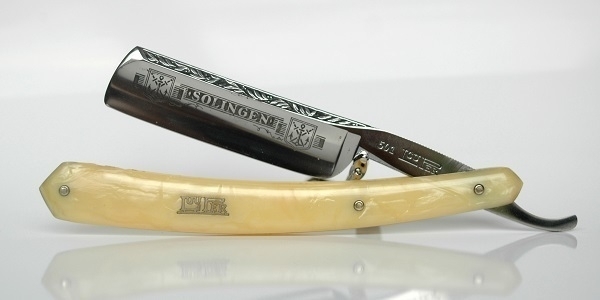Gotta, LouPer
One gets the impression that German-made straight razors tended to be more ostentatious than those made in Sheffield. Brand-names are more prominent; scales are more often decorative; etching and gold-washing on the blade more eye-catching. There would have been a time, in the early years of the last century, when many German-made goods were regarded in the UK, fairly or not, as cheap and inferior imports, so perhaps there was a tendency on the manufacturers' parts to try to compensate by projecting a more de-luxe appearance.

For example here’s a Gotta 120 razor with a 4/8, full hollow ground blade which has a ‘barber’s notch’ at the point. The GOTTA brand-name, one of a few used by the firm of Grah & Plümacher, appears on the scales (which I believe to be celluloid), in gold wash on the blade and again on the tang. On the other side of the tang is the text “Finest Silver Steel / Forged and Ground / in Solingen Germany” (Solingen, like Sheffield, being a traditional centre for bladesmithing and cutlery manufacture).
I’ve been using this one for three years. When it first arrived, the edge on it was formidably sharp, and in my inexperienced hands my first shave with it wasn’t far short of a bloody mess. Not quite a case of “Gotta call an ambulance” but certainly “Gotta be more careful next time!” Since then it has been reliably excellent: I had a great shave with it the other day.

And here’s a LouPer Flamme razor. This one has a 6/8 blade with a ‘French’ point which is decorated along the spine and has SOLINGEN – and the city’s coat of arms – etched into the sides of the blade. On the reverse of the tang is the text “🔥 Flamme / Louper / Solingen”. The scales, again, are probably celluloid, albeit this time with a marbled effect. ‘LouPer’ and ‘Flamme’ were trademarks of the Louis Perlmann company, which originated in Leipzig in the 1860s, but later set up an operation in Solingen, as well as a presence in Berlin. In addition to making blades themselves, they also supplied machinery and material to other cutlery companies.
I obtained the LouPer a few months after the Gotta. Whereas the Gotta was in near-pristine condition, and still had its original box, the LouPer had more signs of prior use, and arrived boxless. Despite that, it too has served me very well. Both razors are likely to have been made between the wars, which raises the unsettling (and potentially unanswerable) question: are these artefacts of the Weimar Republic, or of the Third Reich?